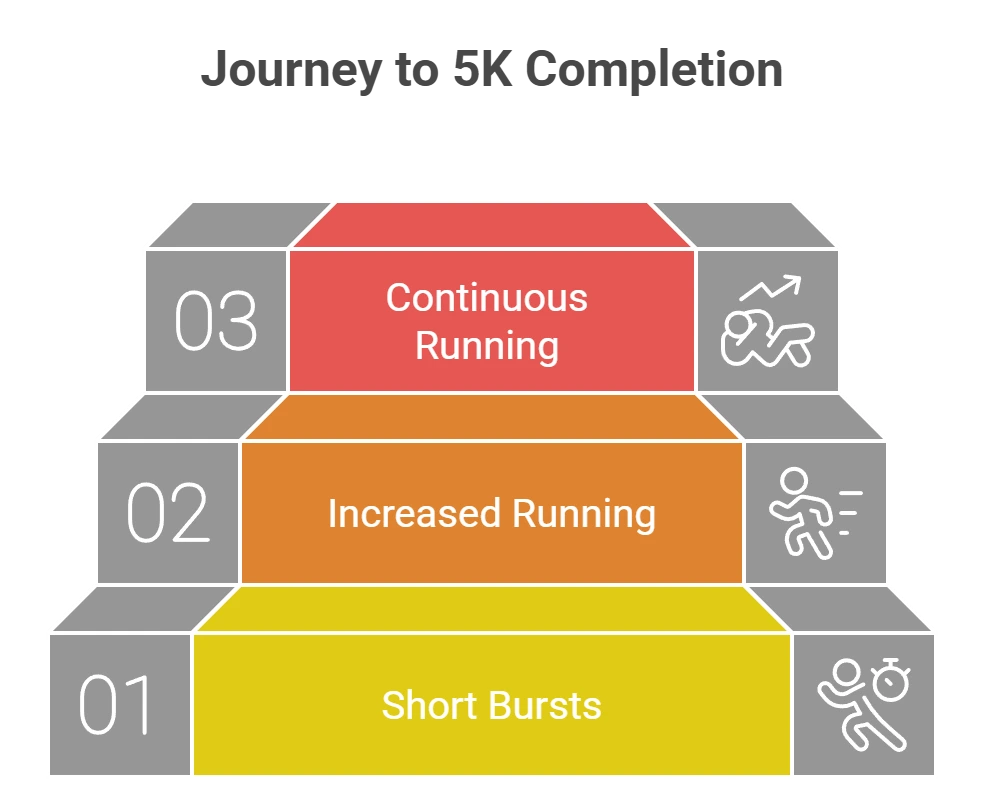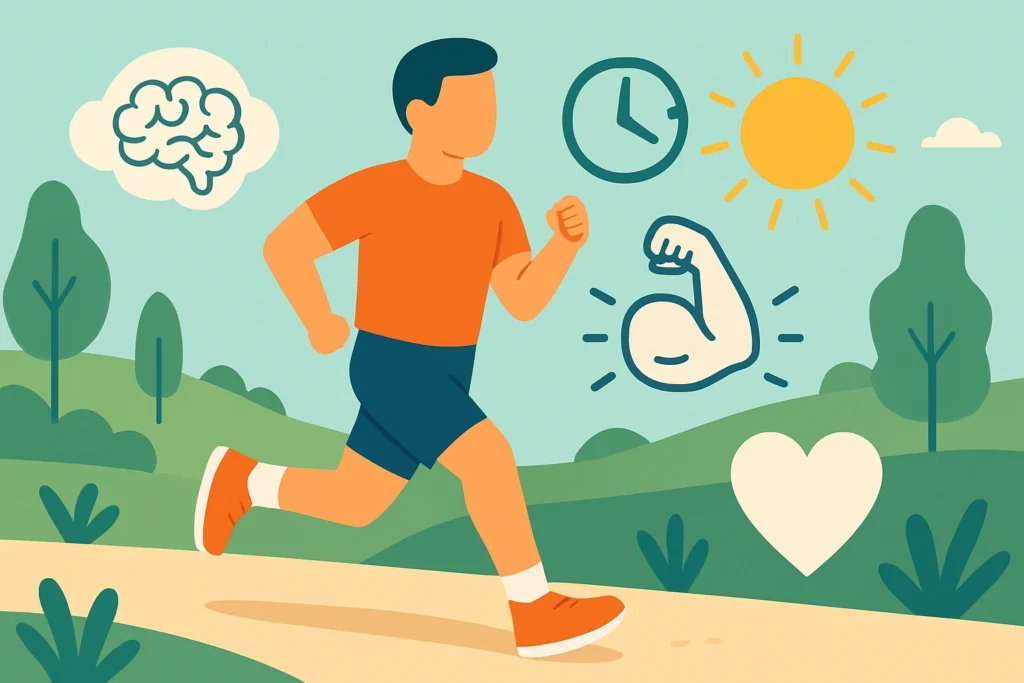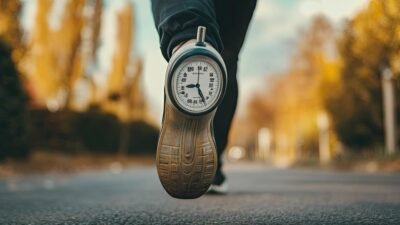Table of Contents
Introduction: Why Running Is a Go-To Fitness Solution
If there’s one fitness trend that never fades, it’s running — and for good reason. It doesn’t rely on gimmicks, subscription models, or high-tech gear. Just you, your shoes, and the open road (or a treadmill, if that’s your thing). Running has stood the test of time because it works. It’s simple, effective, and accessible to nearly everyone.
Whether you’re trying to drop pounds, boost your energy, or finally commit to a healthier lifestyle, running offers one of the fastest returns on effort. No need for expensive equipment or a gym membership — a modest pair of running shoes and the willingness to move are all you need to get started.
In this post, we’ll unpack exactly how running helps you lose weight, why it’s such a powerful fitness tool, and how beginners can go from couch-bound to running a full 5K. We’ll also cover tips to help you stay injury-free, consistent, and motivated — even when life gets busy.
The Science: How Running Burns Fat and Calories
So, what makes running such a powerhouse for weight loss? At its core, running is a high-intensity cardiovascular activity, meaning it demands a lot of energy. The moment you start moving, your body taps into its fuel reserves — burning calories to keep your muscles and heart working.
Here’s how it works:
- Elevated heart rate during a run means your body is working harder, pulling energy (calories) from the food you’ve eaten and, when needed, your stored fat.
- The more intense your effort, the more energy you burn. This makes running one of the most calorie-intensive exercises out there — perfect for those trying to shed weight efficiently.
But that’s not where the magic ends.
Thanks to a phenomenon called EPOC (Excess Post-Exercise Oxygen Consumption), your body continues to burn calories after the workout is done. Your metabolism stays elevated as your system recovers — a little bonus fat-burn while you go about your day.
Still, running alone won’t outpace a bad diet. The real key? Consistency + Nutrition. Regular runs combined with a balanced, calorie-conscious diet lead to sustainable fat loss over time. It’s not about drastic results overnight — it’s about building a routine your body (and mind) can thrive on.
The Couch to 5K Method: From Zero to 5K Hero
You’ve probably heard of it. The Couch to 5K (C25K) program is a global gateway into running — and it’s helped millions go from totally sedentary to confidently crossing a 5K finish line (that’s 3.1 miles for the uninitiated).
So, what is Couch to 5K?
C25K is a structured, beginner-friendly training plan designed to ease you into running. Over the course of 8 to 9 weeks, it gradually increases your stamina through intervals of walking and running, helping you build endurance without overwhelming your body.
What does the weekly structure look like?
While individual plans vary, the general format goes like this:
- Weeks 1–3: Short bursts of running (30–60 seconds) alternated with longer walking breaks.
- Weeks 4–6: Increased running time, reduced walking intervals.
- Weeks 7–9: Continuous running builds up to the full 5K distance.

By the end, most people are amazed at what they’ve accomplished — and how far they’ve come from those first tentative steps off the couch.
Why is it perfect for beginners?
- Gradual progression makes it less intimidating than diving into full-out runs.
- Built-in rest days give your body time to adapt.
- Psychological wins from completing each session build confidence and momentum.
- It’s adaptable — whether you’re recovering from inactivity or starting completely fresh.
Key Benefits:
- ✅ Injury Prevention – By not overloading your joints or muscles too soon.
- ✅ Habit Formation – You’re not just running; you’re rewiring your daily routine.
- ✅ Built-In Motivation – Tangible goals each week keep you coming back.
- ✅ Satisfaction – There’s nothing like running your first full mile — and then pushing further.

Beyond the Scale: The Holistic Benefits of Running
While weight loss might be your why, running offers so much more than what the scale shows. These often-overlooked benefits are what turn casual joggers into lifelong runners.
💓 Cardiovascular Strength & Heart Health
Running strengthens your heart muscle, increases circulation, and helps lower blood pressure and bad cholesterol. It’s like a full-body tune-up for your cardiovascular system — keeping your engine in peak condition.
🧠 Mental Clarity, Reduced Anxiety, and the Famous “Runner’s High”
When you run, your body releases endorphins — natural mood boosters that help combat stress, anxiety, and even depression. Many runners describe a meditative rhythm to the activity — it clears your head like few things can.
⏱️ Better Sleep Patterns
Regular aerobic exercise like running has been shown to improve sleep quality and duration. Your body craves rest to repair and recharge after each run — which means you’ll likely fall asleep faster and wake up more refreshed.
📅 Discipline, Goal-Setting, and Lifestyle Alignment
Creating a running routine fosters self-discipline. When you set and reach small goals (like finishing a week of C25K), it naturally spills over into other areas of life — diet, work, mindset, and more.
🧑🤝🧑 Community and Connection
Whether it’s online forums, local running clubs, or race day crowds, running builds community. Shared goals, shared miles, shared motivation. You don’t have to do it alone — and that sense of belonging can be just as powerful as the physical gains.
Pro Tips for Beginners: Running Smart, Staying Safe
Starting a new fitness journey is exciting — but jumping in too fast can lead to burnout or injury. If you want your running habit to stick (and feel good while doing it), you’ve got to play it smart.
🐢 Start Slow — Intervals Are Your Best Friend
There’s no need to sprint your way into fitness. Alternating between walking and running (like the Couch to 5K method suggests) gives your body time to adapt. It’s also easier on your joints and builds endurance without crushing your spirit.
👟 Choose the Right Running Shoes
Not all sneakers are created equal. Investing in a good pair of running shoes can prevent injuries like shin splints, plantar fasciitis, and joint pain. Tip: visit a specialty store where they assess your stride and foot shape for the perfect fit.
🔥 Warm Up, Cool Down — Always
A few minutes of dynamic stretches (like leg swings or high knees) before your run, and gentle stretching or walking afterward, helps prevent muscle strain and supports recovery. Think of it as bookending your workout with self-care.
🚨 Know the Signs of Overtraining
Sore is okay. Pain is not. Watch out for red flags like:
- Persistent fatigue
- Lingering aches or sharp pain
- Sleep disruption or mood swings
Listen to your body — rest days aren’t weakness, they’re wisdom.
📱 Track Your Progress
Use free or low-cost tools like:
- Apps (e.g., Strava, Nike Run Club, Garmin)
- Wearables (smartwatches, step counters)
- Running journals (paper or digital)
Tracking builds motivation, and nothing feels better than seeing your first mile become your first 5K.
🤝 Stay Motivated with Accountability and Rewards
Find a running buddy, join a group, or even post about your runs online — external accountability boosts consistency. And don’t forget to reward yourself: New playlist? New gear? Cheat meal? You’ve earned it.
Realistic Expectations: Motivation to Keep Going
Here’s the truth many beginners don’t hear enough: results take time, and that’s okay.
⏳ Weight Loss Isn’t Instant — But Progress Is
Yes, running burns calories. But real, sustainable weight loss happens over weeks and months, not days. Focus on consistency over intensity — because the longer you stick with it, the more it compounds.
✅ Every Run Counts
Not every run will feel amazing. Some will be short, slow, or even frustrating. But showing up — lacing up and getting out there — that’s the win. Momentum matters more than speed.
💬 The Journey > Perfection
Missed a workout? Walked instead of ran? That’s part of the process. Let go of perfectionism — it’s not about crushing every run, it’s about becoming the kind of person who doesn’t quit.
🏁 Celebrate the Small Wins
Your first run without stopping. Your first time hitting 10 minutes straight. Your first 5K finish. These milestones matter. They’re proof you’re transforming, one step — one mile — at a time.
Resources & Further Reading
Knowledge is power — especially when it fuels your motivation. Here are some trusted, expert-backed sources to deepen your understanding and keep your journey informed:
- 📘 Mayo Clinic – Running for Weight Loss: Explores the mechanics of calorie burn, heart health, and long-term fitness through running.
- 🏃♂️ ACE (American Council on Exercise) – Benefits of Running: Covers physical, mental, and emotional perks of a consistent running habit.
- 🇬🇧 NHS – Couch to 5K Program: A beginner-friendly, week-by-week breakdown to get you from sitting to sprinting (okay, jogging — but still!).
- 🧠 Harvard Health – The Science of Running: An overview of how running improves everything from metabolism to brain function.
- 📊 Journal of Obesity – Running & Weight Loss: A deep dive into the role of running in sustainable weight management.
Bookmark them, skim them, dive deep — whatever works for you. They’ll help keep your journey grounded in science and supported by evidence.
Conclusion: Your Path Starts Now
You don’t need to be fast.
You don’t need fancy gear.
You don’t need to wait until Monday.
All you need is to take that first step.
Whether you’re looking to lose weight, clear your mind, boost your energy, or simply feel proud of yourself again — running can help you get there. The Couch to 5K method proves that anyone, yes anyone, can go from zero to empowered runner with a little patience and persistence.
This isn’t just about fitness.
It’s about proving to yourself that you can do hard things — and that your best self is just on the other side of “I can’t.”
So go ahead:
✨ Lace up.
✨ Step outside.
✨ Start slow — and don’t stop.
You don’t have to be fast — you just have to begin.
🧠 Frequently Asked Questions (FAQ)
1. How long does it take to complete the Couch to 5K program?
Most versions of Couch to 5K are designed to be completed in 8 to 9 weeks, with 3 sessions per week. However, it’s perfectly okay to go slower and repeat weeks if needed.
2. Do I need to lose weight before I start running?
Not at all. Running can actually help you lose weight safely when combined with a balanced diet. The key is to start slow, listen to your body, and stay consistent.
3. What if I can’t run the full time suggested in the program?
That’s normal at first! The program alternates walking and running intervals to help you build stamina. Modify it to your pace — progress is still progress.
4. Will running hurt my knees?
When done with proper form, shoes, and pacing, running is safe for most people. Start gently, avoid hard surfaces, and include rest days to prevent injury.
5. How do I stay motivated when I don’t see results right away?
Focus on non-scale victories like improved energy, better sleep, and increased confidence. Use tools like apps, journals, or running groups to keep the fire lit.






[…] How To Get Fit Running: From Couch to 5K – The Easy Way […]